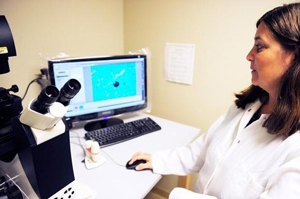By Ana B. Ibarra
Researchers at UC Merced are moving forward with two research projects that aim to better understand Valley fever in the San Joaquin Valley.
The university’s Health Sciences Research Institute recently received approval and funding to conduct patient studies at Children’s Hospital Central California in Madera. Researchers will study the blood of 30 pediatric patients with Valley fever to understand the immune system’s response to the disease.
David Ojcius, a professor of molecular biology at UC Merced, said the long-term goal is to develop a vaccine. Ojcius expects to have samples from the first round of patients sometime this month.
Valley fever, also known as the “silent epidemic,” is an infection of the lungs caused by coccidioides, a fungal parasite found in soil. According to the Centers for Disease Control and Prevention, the fungus is common in dry, low rainfall areas of the United States, such as the San Joaquin Valley. According to researchers, Valley fever is an especially big problem in the southern counties of Central California. Places such as Avenal and Bakersfield are known to have a high infection rate.
In Merced, a lower incidence is observed but that may be attributed to improper diagnosis, researchers said. Valley fever is also common in desertlike regions of Arizona, Nevada, Texas and New Mexico.
Valley fever occurs when microscopic fungal spores are inhaled. Most cases will result in no symptoms or mild influenzalike symptoms, but can also result in fevers and pneumonia. More severe cases can lead to death. The CDC reports that researchers estimate more than 150,000 people a year are affected by Valley fever, although most cases go undiagnosed.
Although Valley fever is not contagious, it is of special concern in years following drought and during shifts of weather patterns, UC Merced researchers said.
In May, coccidioides, the fungus that causes Valley fever, was found in south-central Washington for the first time. However, Ojcius explained that the spreading and finding of coccidioides does not necessarily mean it will result in incidences of Valley fever.
Because of its geographic expansion, the disease is gaining traction. In June the U.S. Food and Drug Administration added the fungus that causes Valley fever to the list of pathogens eligible under the Generating Antibiotic Incentives Now Act.
Researchers at UC Merced hope this new light on the disease will bring funding for additional research.
“There is now interest about Valley fever on a national level,” said Katrina Hoyer, professor of molecular biology at UC Merced. “We’re hearing rumblings on some federal money.”
Read the full article in the Merced Sun-Star.
Photo courtesy of Christopher Winterfeldt.

